“There are three deaths. The first is when the body ceases to function. The second is when the body is consigned to the grave. The third is that moment, sometime in the future, when your name is spoken for the last time.” - David Eagleman in Sum: Forty Tales from the Afterlives
Die, But Once offers a supplementary ruleset for fifth edition Dungeons and Dragons. It supports characters engaging in funeral practices for a fallen party-mate, and manipulates the mechanical systems of Dungeons and Dragons to ensure players feel that the experience has left lasting change.
Key Duties
Project management of multidisciplinary team to ensure high-quality production (waterfall methodology)
Game design developing new mechanics within existing structural frameworks
Identification of design gaps through ethnography and understanding of player stories
Management of funding through an early-access roadmap
Art and layout direction, including selection of typeface and page effects
Big Wins
Successful funding via early-access model, allowing for increased art budget and staggered release
Delivery of all critical path elements on time and on budget
Emphasis on player agency in a low-agency game-state
Blending of modern palliative approaches to “Good Death” with traditional game play
Reception of humbling praise from established Wizards of the Coasts writers.
Praise for Die, But Once
"What a great look at death in DnD, especially for a low-magic campaign. Read this; you aren't expecting what it's got for you."
James Haeck
(Writer and Desginer - Wizards of the Coast)
"I'll have this ready at my table for any ruleset, it's lovely. Put it in your toolbox."
Matt Horam (Director - EttinCon)
New saplings from old soil
Designing with the limitations of an existing mechanical framework is a wonderful challenge for any structuralist. The Fifth Edition of Dungeons and Dragons (2014) reduced a significant number of mechanical “moving parts” in the name of accessible simplicity. With the removal of those levers, supplemental designers have lost many of the dials they could turn and levers they would pull. For example, the main mechanical benefit of “Advantage” is a much more simple assessment, but it loses some fidelity. From the old version 3.5 method (2003) of scaling modifiers, there were options to fiddle with these granular benefits (for example, a benefit could provide +1, or +2, or +3, where now they all only provide the same “advantage”).
Making death have a (mechanically supported) “impact” within this reduced mechanical system was difficult. Giving players benefits that they want, that feel like their character has fundamentally changed meant looking for elements they don’t normally gain. Fifth edition provides too many sources of the same small bonus, and the bounded accuracy is too tight to allow space for a big bonus. However, when the road ahead is blocked, there is always another option: Orthogonal design.
Die, But Once understands the difference between what characters can do and what they are. Between the verbs (or avenues of influence) that players bring to bear against the conflicts of a game, and the identity of the character (or of the player, where bleed occurs). So often these become one and the same, but their slight differences are what allows Die, But Once to be a story about the dwarven rogue Tilikup gaining acces to Malsuvius’ fireball, and not a story about Tilikup learning fireball for himself.


